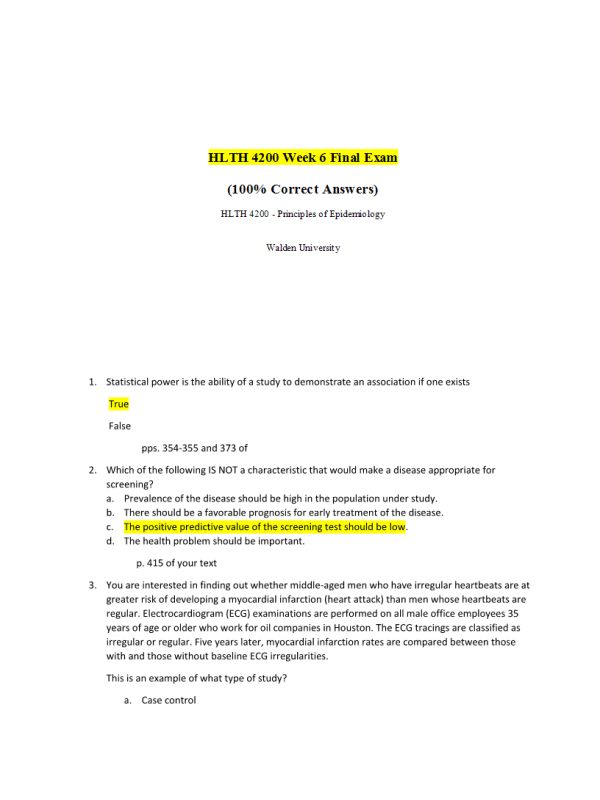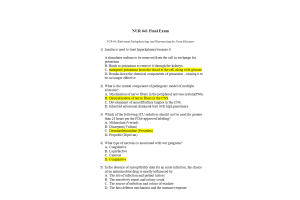HLTH 4200 Week 6 Final Exam (All Correct)
Course : HLTH 4200 Principles of Epidemiology
Contributed : Anastasia
- $25.00
- Question: Statistical power is the ability of a study to demonstrate an association if one exists
- Question: Which of the following IS NOT a characteristic that would make a disease appropriate for screening?
- Question: You are interested in finding out whether middle-aged men who have irregular heartbeats are at greater risk of developing a myocardial infarction (heart attack) than men whose heartbeats are regular. Electrocardiogram (ECG) examinations are performed on all male office employees 35 years of age or older who work for oil companies in Houston. The ECG tracings are classified as irregular or regular. Five years later, myocardial infarction rates are compared between those with and those without baseline ECG irregularities.
- Question: The physical examination records of the incoming freshman class of 1935 at the University of Minnesota were examined in 1980 to see whether their recorded height and weight at the time of admission to the university are related to their chance of developing coronary heart disease by 1980.
- Question: Research participants were children enrolled in a health maintenance organization. At 18 months of age each child was randomly assigned to one of two groups. Each group was given one of two types of vaccine against Haemophilus influenza. Parents were asked to record any side effects on a card and mail it back after two weeks.
- Question: Research participants with a confirmed diagnosis of carpal tunnel syndrome were compared to a comparable group without carpal tunnel syndrome. Both groups were asked about their prior occupational and recreational exposures.
- Question: The entire population of a given community is examined and all who are judged to be free from bowel cancer are questioned extensively about their diets. These people then are followed for several years to see whether or not their eating habits will predict their risk of developing bowel cancer.
- Question: In order to reduce random error and increase the strength of the findings, researchers should use a small sample size.
- Question: In the Bradford Hill Criteria for Causation, the ________ the association, the more likely it is that the relation of "A" to "B" is causal.
- Question: The positive predictive value of a screening test indicates the:
- Question: The specificity of a screening test indicates:
- Question: The primary difference between an experimental and observational study is that the investigator:
- Question: In contrast to observational studies, clinical trials are used to test the:
- Question: The process in a clinical trial whereby the investigator assigns subjects to either the treatment or comparison/control group is known as _________________.
- Question: A good screening test should be ____________.
- Question: In the Framingham study, a group of residents had been followed since the 1950s to identify occurrence and risk factors for heart disease. Which type(s) of study does it represent?
- Question: The Cancer and Steroid Hormone (CASH) study asked women with breast cancer and a comparable group of women without breast cancer about their prior use of oral contraceptives ( the Pill ). What type of study does this represent?
- Question: An intervention designed for the purpose of educational and behavioral changes at the population level is a community intervention.
- Question: Certain genes can be markers for susceptibility but do not confer risk on their own
- Question: The host, agent, and behavior make up the epidemiologic triangle.
- Question: In developed countries, chronic health problems have replaced infectious diseases as the leading killers during the past century.
- Question: The entry and development or multiplication of an infectious agent in the body of persons or animals is known as:
- Question: The severity of a disease produced by an infectious agent is referred to as:
- Question: All of the following are examples of diseases known or believed to have a genetic basis EXCEPT:
- Question: Highly toxic chemicals that persist in the environment have been associated with disruption of the:

